
I love this opening shot—the sweeping curves of the staircase amidst the straight lines of the floor and ceiling tiles, the doors and wall patterns. The sea of blue broken up by the warm light of the lamps.
It just invites you to look around and explore.
Review by Jay Wilson I adored The 7th Guest growing up, and returning to it two decades later I expected—not to hate it—but not to love it either. At a time when most games still used 2D sprites against flat backgrounds, the 7th Guest emerged with a fully realized prerendered 3D mansion to explore. And when you followed the beckoning skeletal finger deeper into Henry Stauf‘s domain, it didn‘t cut or fade from one static image to another. Oh no, the camera glided through the three-dimensional space to the next point of interest. You were inside the haunted house. You were in the game world. And even though you could only move between predetermined points and interact with select items, it felt like you could do anything. Explore anywhere. But that was 1993. The 7th Guest is no longer the one of a kind technical marvel it used to be. This is 2017. The graphics are outdated, the frame rate lacking, the interactivity is minimal, and holy crap does the low res digitized video and clunky blue screen date it. Furthermore, the gameplay involves solving puzzles of which I still have a keen memory after twenty-four years. How does the game stand against the passing of time? I really didn‘t think it could, and I was not about to write it any free passes on account of my childhood fondness, its reputation, or the technical limitations of its era. I judged it against the same criteria I hold for any other video game. 
I love how the toy soldier casts an ominous shadow over what should be an innocent playroom.
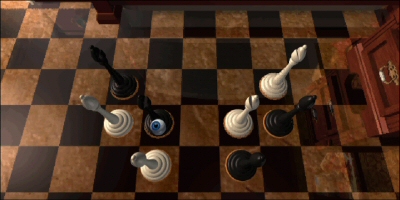
Inside a puzzle sequence, an eyeball indicates a legal move. Furthermore, the iris will change color to differentiate one possible move from another.
Was it fun? Did I enjoy playing it? Yes, yes, and yes. After a fresh playthrough, I still love The 7th Guest. It frustrates me a lot more now than it did back then, and there‘s a glaring bit of microscopic bullshit that taints the experience towards the end; however, despite the occasional stumbling, I still relish the journey—the setting, the atmosphere, the immersion. I feel like I step into that mansion straight out of a Grimm fairy tale, and I want to explore—I want to unlock all the doors, solve all the puzzles, and learn the fate of the six guests. And I attribute much of this to the presentation. Just look at the screens. The pristine mansion is beautifully framed and somehow successfully attains a creepy atmosphere by virtue of its emptiness and traumatic history rather than the more overt dust, spiderwebs, and gothic decor. The music matches it in tone and richness with cues like the strangely soothing Ghost of Bo which sounds like a journey through the ethereal plane and Dolls of Doom which makes great use of a celeste‘s call and answer to create an enigmatic and tragic echo that seems to carry the nightmare out of the past to haunt the present. And finally, the single trait caricatures of the titular guests mirror the kind of simple characters that populate Hansel and Gretel, Repunzel, and Rumpelstiltskin—played perfectly by a surprisingly capable cast lead by Robert Hirschboeck whose Shakespearian grace and grandeur elevates Henry Stauf into an ever-present Faustian presence of pure malevolence. Watching. Waiting. And taunting. Stauf is not a human being of flesh and blood, of complexities and nuance, of logic and convictions, but rather a legend—a manifestation of imagination and fear—whispered under the moonlight in hushed tones by young boys trying to scare each other at the gates of a creepy derelict abode. Together, these elements paint a charming portrait of an engaging ghost story uncovered one puzzle at a time. 
Notice the transparency in the live action elements. The 7th Guest‘s cinematics are presented like a haunted house story where the ghosts of the deceased are doomed to reenact their final night.
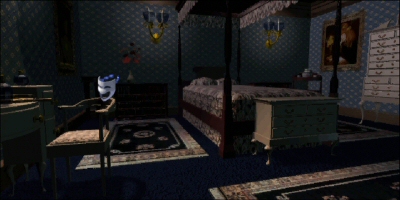
The developers made each guest’s room custom tailored to their archetypal personalities; likewise, composer George “the Fat Man” Sanger gave each guest their own distinct musical theme, insuring something new and unique resides behind each door.
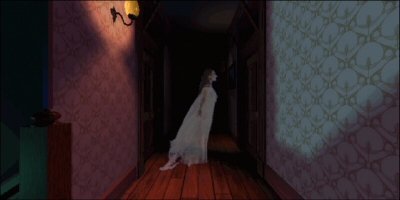
No ghost story is complete without random apparations appearing. Fortunately, this ghost‘s appearance becomes less frequent the deeper into the game the player delves.
Puzzles that will have you cutting cakes, moving chess pieces, spelling words in pantry cans, commanding spiders, throwing knives, channeling blood on a carpet, and even navigating a maze with a straight forward point and click interface. Click the object you want to move, and then click where you want to move it. And if you pick the wrong spot, you can mercifully right click to skip the animation. The puzzles that hold up the best feature a simple spatial premise and require logic and experimentation to solve. For example, how do you place eight queens on a chessboard so that no two are attacking each other? What‘s particularly brilliant is how quickly the rules manifest themselves with only a handful of exploratory clicks and rudimentary observation. Click on the empty chess board, and a queen emerges from the selected square. Click somewhere else, and another queen rises. Click a third point, and both queens melt away, replaced by a single queen where their threatened squares collide. No tutorial necessary. Or consider the crypt puzzle where you must close nine coffins arranged in a three-by-three grid. Some start out open. Some start out closed. When clicked, closed coffins open, and open coffins close. It‘s essentially a simplified Rubik‘s cube with each selected casket affecting not just itself, but those adjacent to it as well. Several clicks in, a pattern emerges, a consistent predictable pattern. And that is where the gameplay lies—staring at the screen and planning out, “If I click you, then those two close, and that one opens which lets me click this fellow, and that gets me everything in northwest corner. So, now if I open up those two in the middle, it gives me the four I need, and if I click here then that should be—damn it! Still one left ...” Now the word predictable usually has a negative connotation; however, in the context of a puzzle whose rules have to be intuited, predictable is not only a positive feature, it is critical. In the coffins and queens puzzles, I know exactly what‘s going to happen with each click of the mouse under every single imaginable circumstance, and that predictability paradoxically permits variety and replayability, allowing me to attack an obscure goal from any possible position with the confidence that I‘m not throwing darts in the dark. And sure, years later I may still remember the end goal and the general method of reaching it; however, I don‘t recall the exact solution sequence which lets me rediscover it and relive the experience. Contrast this with the “There is no possible way” riddle which I remember a quarter of a century later, and I will remember until the day I die because the solution is a sentence. And when learning the planets, the order of operations, or notes in music class, what do they always do? They give you a sentence because, “Please excuse my dear aunt, Sally” is easier to recall than “Parenthesis, exponents, multiplication, division, addition, subtraction.” Likewise, “There is no possible way” is easier to remember than the series of moves required to swap four black bishops and four white bishops. Hell, I remember the cake puzzle solely because of Stauf‘s verbal introduction, “Two skulls and two stones, the rest is just icing.” We deal with spoken language every day of our lives; thus, we remember spoken language better. Thus, the language-dependent puzzles don‘t hold up and, truthfully, really weren‘t that satisfying the first time around either. 
The chattering teeth triggers an animation, some goofy like objects dancing around, others nightmarish like phantom hands trying to reach through a painting.
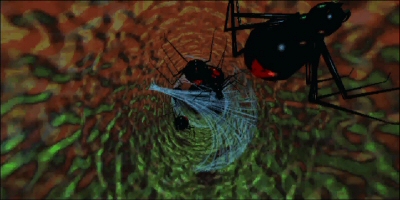
Secret passages exist to help navigate the mansion.
Some rooms such as the art gallery, chapel, and laboratory can only be accessed via secret passage. Puzzles with arbitrary rules also fall short such as the skyscraper puzzle and the spider puzzle. The former requires clicking on the correct windows to light all the way up to the top and is essentially Trilobyte, the developer, saying, “Guess what I‘m thinking.” And therein lies the problem: it‘s all guess work. Trilobyte decided options A, B, and C dead end, but option D goes on to another set of predetermined choices, and all you can do is keep guessing. No patterns, thus no logic and no strategy—just click every possible combination and eventually you‘re guaranteed to solve it, and it won‘t even take very long. However, the “just click everything” approach doesn‘t work for the aforementioned coffins because, like a Rubik‘s cube, the very same move that solves it, if used at the wrong time, completely screws it up. You could theoretically work on it forever. And beating a game that could theoretically never end is infinitely more satisfying than one that‘s guaranteed to end. The spider puzzle works better but lacks the self-instructing brilliance of the chess pieces puzzles because its rules are so arbitrary that it‘s impossible to figure out. You have seven moves to get seven spider on seven points of an eight-sided star, but a move as defined by the game isn‘t over until you summon a new spider. Or in other words, you can move the same spider multiple times as part of the same move. But that connection isn‘t so obvious when attempting the puzzle for the first time; Stauf seems to randomly declare that you‘ve lost and resets the game. Sometimes he lets you play a handful of moves. Sometimes he lets you play dozens of moves. And you all but have to turn to the hint book in the library just to figure out why. Going back to the Queens puzzle, there‘s only two states for each square: empty or occupied. Since the whole board starts out empty, naturally the solution is to occupy the squares. How many? You don‘t have to know. It doesn‘t matter. And what if you don‘t play chess? That doesn‘t matter either because a queen‘s threatened squares—vertical, horizontal, and diagonal—is easily observable and consistent (i.e. predictable). It doesn‘t take a 2000+ELO Grandmaster to notice that two queens in the same path always disappear. Same thing with the coffins. Two states: open or closed. Although in this case, since they started out with a mixture of some open and some closed, it informs you to get them all in the same state. If you get them all open and nothing happens, guess what? It immediately occurs, “Crap! I was supposed to close them.” I know because I do it all the time. 
The game actually runs in letterbox format for a more cinematic experience (especially on the 4:3 CRT monitors at the time.) Clicking on the black bars returns to the main menu or resets the current puzzle. I cropped them out because it looked funny in this layout, and they‘re not vital to the gameplay.
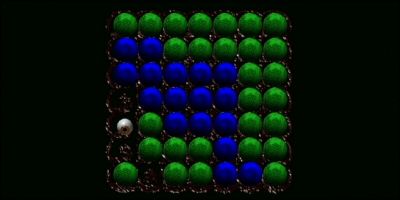
The infamous microscope puzzle. I spent many hours playing this as a kid solely for bragging rights because nobody else I knew could beat it. As an adult, I realize it‘s bullshit, and I don‘t have the patience for bullshit anymore.
Once you know what you‘re supposed to be doing, the spider puzzle becomes fun and entertaining; however, there‘s no sense of “I did it all completely on my own. I figured it out, and then I beat it.” You had to go to the help book. You had to be told the rules. You had to cheat. But the absolute worst puzzle is the microscope where you have to play a computer CPU, a chip designed to do superhuman calculations and is incapable of faltering logic, in a one on one battle of calculation and logic. It‘s legendary in its difficulty, and to this day the only consistent method of beating it is to use another computer program capable of deeper analysis specifically designed to beat it. Fortunately, the microscope puzzle is an optional bonus puzzle, and referencing the library hint book three times will bypass it entirely; however, then the OCD kicks in and says, “You didn’t really beat The 7th Guest, now did you?” Well, actually, yes. Yes, I have. Twice. | ||||||||||||||||||||
|
| ||||||||||||||||||||
